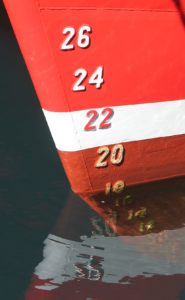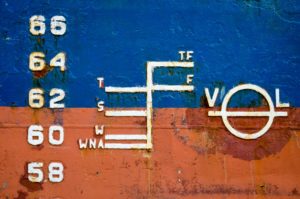Draft Marks and Load Lines
 Draft Marks
Draft Marks
- The vessel’s draft refers to how deep the bottom of the keel is below the waterline.
- It’s useful to have a good understanding of a vessel’s draft as it indicates the depth of water that a vessel can safely pass through.
- Draft marks also indicate how the ship is trimmed fore vs aft. Note that it’s generally understood to be the case that a ship is more seaworthy and handle better if it’s trimmed by it’s stern. This means that the stern is lower in the water than the bow.
- Draft marks are typically found on the hull on either side of the stem (as seen in the picture to the right), amidships, and near the stern. Reading draft marks can give a person an understanding of the trim of the ship as well as how heavily it is set in the water. The trim refers to the position of the ship in terms of it’s forward and aft drafts.
- The measured distance that draft marks represent is always measured from the bottom of the painted numbers. In the picture to the right, the draft at the bow is approximately 18 and a half feet.
- Metric draft marks will similarly indicate distances by using the bottom of the number painted on the hull. Metric draft marks will also typically have numbers measuring every 20cm.
- On some ships, roman numerals are used to indicate draft measurements. Reading roman numerals 1 through 20 is done as follows:
| Number | 1 | 2 | 3 | 4 | 5 | 6 | 7 | 8 | 9 | 10 |
| Roman Numeral | I | II | III | IV | V | VI | VII | VIII | IX | X |
| Number | 11 | 12 | 13 | 14 | 15 | 16 | 17 | 18 | 19 | 20 |
| Roman Numeral | XI | XII | XIII | XIV | XV | XVI | XVII | XVIII | XIX | XX |
 Load Lines
Load Lines
- Load lines are lines on the hull of a ship meant to indicate maximum load capacity for the ship.
- The process of determining load lines involves calculations based on several factors, including the ship’s dimensions, displacement, buoyancy, and stability.
- Load lines are painted at the ship’s forward and aft pivot point in an attempt to account for a forward and aft rocking of the ship during load line measurement.
- The true measurement of the load line is the top of the painted line. This is done so that in any confusion between the top or bottom of the line, it errs on the side of safety.
- The circle with the line through it represents the Summer Load Line indicating the maximum draft or immersion of the ship when it is loaded to its summer draft in temperate waters.
- The marks that accompany this symbol provide further clarification based on different sea conditions because the buoyancy of a ship changes when there are differences in temperature and salinity. While several conventions exist, the load lines in the Plimsol mark commonly indicate the season or location of seas by the following abbreviation:
| TF | Tropical, Freshwater |
| F | Freshwater |
| T | Tropical |
| S | Summer |
| W | Winter |
| WNA | Winter, North Atlantic |
- In this example, tropical refers to tropical waters with sea temperatures of 20 degrees Celsius.
